Hi, what do you want to do?
Curated OER
Energy and Life
This two-page quiz mostly covers ATP, but touches on autotrophs and heterotrophs, as well. Learners show what they know through multiple choice, fill-in-the-blank, and short-answer questions.
Curated OER
THE FARMER CARES FOR THE LAND
Students will identify cause and effect relationships in issues relating to Agriculture and the environment.Ask students to describe what farmers do. Then ask students to define the word "environmentalist." Ask students if they have...
Curated OER
Enzymatic Browning Experiment
Students, in groups, experiment with Heat Blanching, Vitamin C Dip, and Sulfur Dioxide Dip to see if they can prevent enzymatic browning.
Curated OER
Slurrp
In this agriculture worksheet, middle schoolers find the facts needed to construct a website focused around giving information about products that are made from corn.
Chiral Publishing
Chiral Publishing: An Introduction to Chemistry: Important Substances in Food: Audio Book
Learn about the chemical compounds in the foods that you eat everyday. By viewing this audio book, you'll see many structural formulas of these compounds. Also find links to other chapters in the online textbook, animations, and power...
Other
Scimat: Foods Under the Microscope
A technical site that describes different types of microscopes and delves into the chemical makeup of milk, yogurt, various various types of microorganisms. Impressive pictures supplement the text. Links to images of microorganisms.
Smithsonian Institution
National Museum of Natural History: American Mammals: Stephen's Woodrat
Juniper trees are the main source of food, water, and shelter for Stephen's Woodrat. Like Red Tree Voles, which feed mostly on Douglas-fir, the Woodrats are able to feed primarily on conifer leaves, which contain chemical compounds -...
Science Bob Pflugfelder
Science Bob: Homemade Slime!
Contains a procedure for creating slime -- a polymer formed by mixing water, borax, Elmer's glue, and food coloring. Following the procedure, the site contains a brief description of what polymers are.











